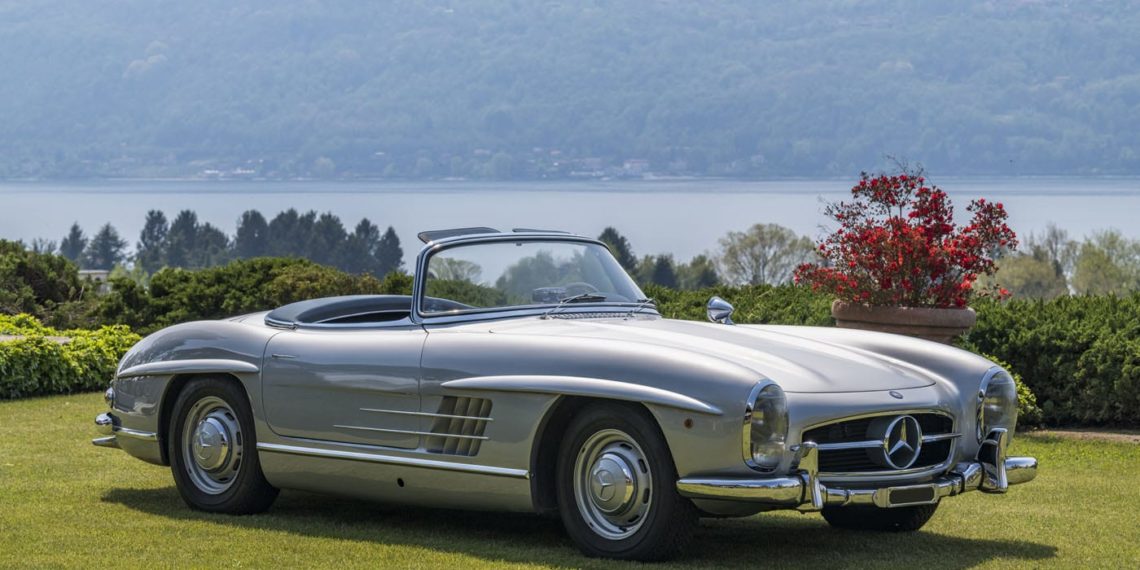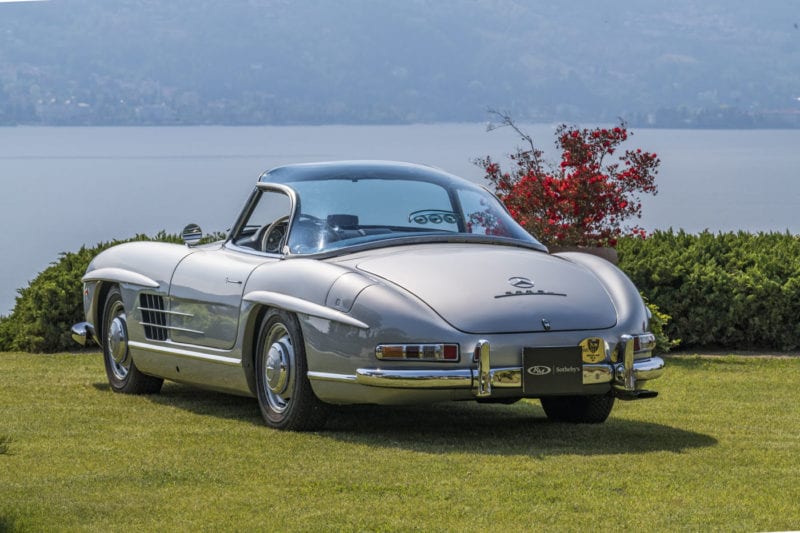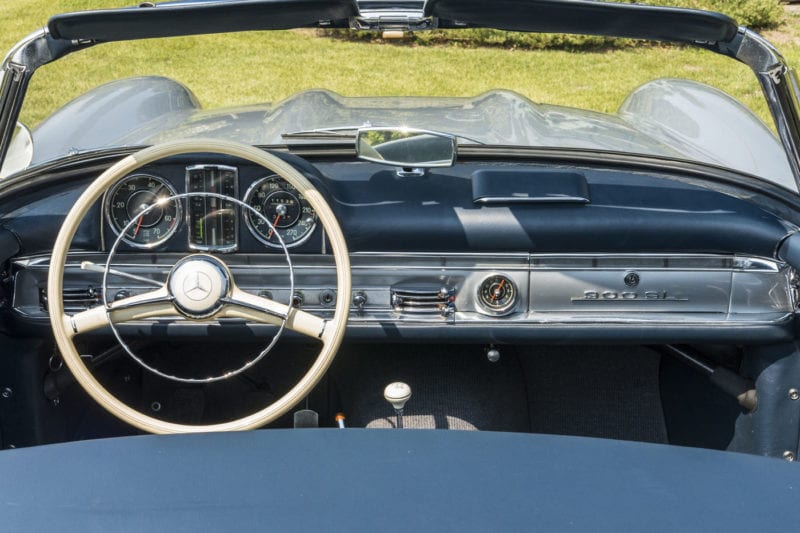Presented by RM Sotheby’s – Like so many of the legendary road cars of the 20th century, the Mercedes-Benz 300 SL was born as a result of a manufacturer captivating the imagination of the automotive world through the domination of the most prestigious motorsport events; in 1952 Mercedes had not only placed 1st and 2nd at the 24 hours of Le Mans, but also 1st, 2nd, and 3rd at the Nürburgring and 1st at the Carrera Panamericana.
The racing car that had achieved these feats was the brainchild of the legendary Rudolf Uhlenhaut, who had been tasked by Mercedes-Benz to restore the motorsport pedigree of the Company using their new production 3-liter engine. Conscious that the pre-war chassis that were available to him were far too heavy to be competitive as a racing sportscar, Uhlenhaut created a clean sheet design that used a tubular spaceframe made from interconnected triangles, which resulted in an extremely rigid yet featherweight solution. Tipping the scales at just 82-kg, it was handicapped only by the requirement for the frame flanking the cockpit to extend upwards, to ensure no stiffness was lost, which in turn necessitated the introduction of a design element that is perhaps one of the most widely recognized in automotive history, gullwing doors.
Aside from the infamous door design, the bodywork was also honed to reduce its drag coefficient to a remarkable 0.25, with even the engine being canted 50 degrees to allow for a lower bonnet line. As well as tilting the powertrain, Uhlenhaut’s engineers managed to raise the power output from 115 Hp at 4600 rpm to 171 Hp at 5200 rpm and the rest, as they say, would have been history but for a certain Max Hoffman.
Hoffman had become the sole distributor for Mercedes-Benz in the USA in 1953 and had seen the reaction of his customer base to the triumphs of the 1952 racing season. So confident was Hoffman of his ability to read a market, that he approached Mercedes-Benz and implored them to make a road-going variant of the 300 SL racer; a request that Mercedes-Benz would have likely dismissed as fantasy had Hoffman not guaranteed an order of at least 1,000 cars. Thus, the planned development for the racer was put on hold, in deference to the production of what would be unveiled to the world at the 1954 New York Motor Show as the Mercedes-Benz 300 SL.
The reaction was ubiquitous in its praise for the car, with journalists falling over each other to heap compliments on what Mercedes-Benz had created: a genuine road-going version of the 300 SL racer; a car with the various creature comforts required to satisfy the most well-heeled of sports car buyers, alongside all the upgrades that Mercedes-Benz had developed for its racing version. The most noteworthy of these upgrades was the introduction of Bosch fuel injection for the engine, which raised the power output to 240 bhp and unlocked a top speed in excess of 160 mph, according to which final drive ratio was specified. Over the course of the next three years, 1,400 examples were produced before Mercedes-Benz decided to shift production and answer the calls for a roadster variant, which had been growing ever louder from across the Atlantic.
The roadster was far more than just a convertible version of the coupe. With the extra time for development, Mercedes-Benz was able to create a more ergonomic and user-friendly car, correcting some of the inevitable weaknesses that the hurried conversion of the racer into the road car in 1954 had brought with it. Most noticeably, the chassis was successfully altered from the firewall backwards to permit the use of conventional doors with winding windows, whilst adjustable seats were also fitted alongside a glovebox, longer wiper blades, wider wheels and a basket of items from the contemporary 300 Saloon. Under the bonnet, the Bosch fuel injection system was perfected, the sports camshaft option became standard, and power was now transmitted to the road via a low pivot swing axle, which transformed the rear stability of the car. A total of 1,858 300 SL Roadsters were produced from 1957 to 1963, a remarkable figure given the stratospheric cost of the car at the time.
This particular car is an early example and was delivered to its first owner in Rome on 14 August 1957 and registered on Roma numberplates as 284882. That gentleman was none other than Luigi Innocenti, of the Innocenti Company who owned one of the biggest factories in Italy, producing Lambretta’s, Minis and much more, from its base in Lambrate. Innocenti enjoyed the car for the rest of the summer of 1957 before passing it onto its second owner, Count Werner Rodolfo of Milan on 28 February 1958, who registered it on the Milan numberplate 590064 MI. During Count Werner’s ownership, the car was repainted from its factory silver to metallic light blue and retrimmed in none other than leopard print cloth. It was also joined by a special one-off glass hard roof, created by Count Agusta of Agusta helicopters who also owned a 300 SL and was a close friend of Count Werner.
It passed into the hands of the father of its current owner on 16 September 1976 after years of persuading Count Werner to part with the car. It has remained in the family ever since and benefitted from a light restoration in 2009 when the car was returned to its factory color of silver. Its owner is keen to stress that it was not a substantial project as the bodywork was still in fantastic condition, but instead was a comprehensive cosmetic and mechanical overhaul. It should not come as a surprise therefore that the car presents in beautiful condition throughout today.
A careful inspection has confirmed that the engine, chassis, rear axle, front uprights on both sides are matching the build sheet. The panels that could be removed revealed the body number 141. The speedometer mentions the 3,64:1 ratio that is also stamped on the rear axle, and the five wheels are dated 1957.
A very genuine example, European specification, matching number powertrain and colors, fitted with a unique hardtop that would attract the eyes of the judges of any concourse! This vehicle will be offered in RM Sotheby’s new Milan Sale, taking place 15 June at Palazzo Serbelloni in Italy. The sale will be livestreamed and remote bidding options are available.














